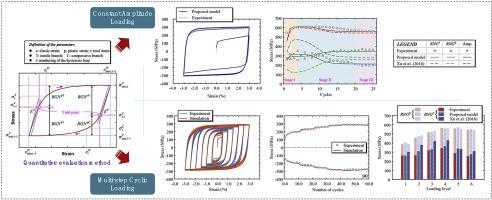当前位置:
X-MOL 学术
›
Mech. Mater.
›
论文详情
Our official English website, www.x-mol.net, welcomes your feedback! (Note: you will need to create a separate account there.)
An improved elasto-plastic constitutive model for the exquisite description of stress-strain hysteresis loops with cyclic hardening and softening effects
Mechanics of Materials ( IF 3.9 ) Pub Date : 2020-11-01 , DOI: 10.1016/j.mechmat.2020.103590 Li-Yan Xu , Jian-Sheng Fan , Yue Yang , Mu-Xuan Tao , Zhen-Yun Tang
Mechanics of Materials ( IF 3.9 ) Pub Date : 2020-11-01 , DOI: 10.1016/j.mechmat.2020.103590 Li-Yan Xu , Jian-Sheng Fan , Yue Yang , Mu-Xuan Tao , Zhen-Yun Tang

|
Abstract In this study, a finite cyclic elasto-plastic constitutive model is developed to simulate the cyclic hardening and softening of the low-yield-point steel BLY160. Compared with existing models, an improved description of the stress-strain hysteresis loops is achieved by introducing a modified Chaboche kinematic hardening rule and a nonlinear isotropic hardening rule extended with a strain memory surface. In the proposed kinematic hardening rule, the backstress is decomposed into three parts for short, middle, and long ranges, with each of them obeying an Armstrong-Frederick (A-F) evolution rule consisting of a linear hardening and dynamic recovery term. To incorporate the significant effect of the kinematic hardening rule on the shape change in hysteresis loops, a dynamic recovery coefficient is postulated herein to develop with not only the accumulated plastic strain but also the memorized strain range. In addition, a hardening factor is introduced to the linear hardening term to consider the different plastic moduli of monotonic and cyclic deformations. The model parameters are identified in an exquisite manner by discriminating the contributions of the isotropic and kinematic components to the cyclic hardening and softening phenomena, which is implemented through a quantitative evaluation of the tested hysteresis loops. The comparison between the numerical prediction and experimental results indicates that the developed constitutive model can elaborately simulate the cyclic behaviour of the investigated steel. The results demonstrate that the entire evolution process of the stress-strain hysteresis curve characterized by the cyclic hardening and softening, transient Bauschinger effect, and strain-range dependence can be adequately described by the proposed model.
中文翻译:

一种改进的弹塑性本构模型,用于精细描述具有循环硬化和软化效应的应力-应变滞后回线
摘要 本研究建立了有限循环弹塑性本构模型来模拟低屈服点钢BLY160的循环硬化和软化。与现有模型相比,通过引入改进的 Chaboche 运动硬化规则和扩展了应变记忆表面的非线性各向同性硬化规则,实现了对应力-应变滞后回线的改进描述。在提议的运动硬化规则中,背应力被分解为短、中、长三个部分,每个部分都遵循由线性硬化和动态恢复项组成的 Armstrong-Frederick (AF) 演化规则。为了结合运动硬化规则对磁滞回线形状变化的显着影响,这里假定动态恢复系数不仅与累积塑性应变有关,而且与记忆的应变范围有关。此外,在线性硬化项中引入了硬化因子,以考虑单调和循环变形的不同塑性模量。通过区分各向同性和运动学分量对循环硬化和软化现象的贡献,以精细的方式确定模型参数,这是通过对测试磁滞回线的定量评估来实现的。数值预测与实验结果的比较表明,所开发的本构模型可以精细地模拟所研究钢材的循环行为。
更新日期:2020-11-01
中文翻译:

一种改进的弹塑性本构模型,用于精细描述具有循环硬化和软化效应的应力-应变滞后回线
摘要 本研究建立了有限循环弹塑性本构模型来模拟低屈服点钢BLY160的循环硬化和软化。与现有模型相比,通过引入改进的 Chaboche 运动硬化规则和扩展了应变记忆表面的非线性各向同性硬化规则,实现了对应力-应变滞后回线的改进描述。在提议的运动硬化规则中,背应力被分解为短、中、长三个部分,每个部分都遵循由线性硬化和动态恢复项组成的 Armstrong-Frederick (AF) 演化规则。为了结合运动硬化规则对磁滞回线形状变化的显着影响,这里假定动态恢复系数不仅与累积塑性应变有关,而且与记忆的应变范围有关。此外,在线性硬化项中引入了硬化因子,以考虑单调和循环变形的不同塑性模量。通过区分各向同性和运动学分量对循环硬化和软化现象的贡献,以精细的方式确定模型参数,这是通过对测试磁滞回线的定量评估来实现的。数值预测与实验结果的比较表明,所开发的本构模型可以精细地模拟所研究钢材的循环行为。


























 京公网安备 11010802027423号
京公网安备 11010802027423号